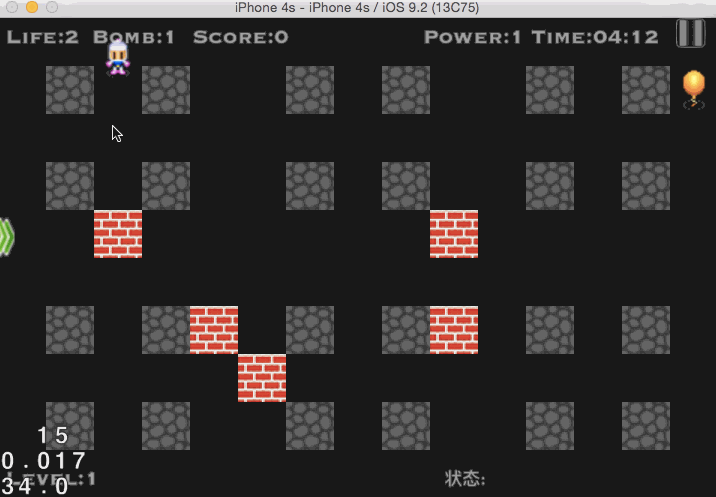大熊猫猪·侯佩原创或翻译作品.欢迎转载,转载请注明出处. 如果觉得写的不好请多提意见,如果觉得不错请多多支持点赞.谢谢! hopy ;)
上篇介绍了游戏主角的初始化方法,下面我们一次来实现主角的其他方法,首先来看看runAnimation方法,我们使用这个方法来播放主角的动画:
-(void)runAnimation:(CCAnimation*)animation{ if (_curAnimation == animation) { return;
}
_curAnimation = animation; if (_curAnimate) {
[self stopAction:_curAnimate];
}
_curAnimate = [CCActionRepeatForever actionWithAction:
[CCActionAnimate actionWithAnimation:animation]];
[self runAction:_curAnimate];
}
代码首先检查将要播放的动画是否和当前正在播放的动画相同,如果相同则直接退出.然后如果当前正在播放动画动作,则将其停止.
接下来为需要播放的动画创建一个永久循环的动作,然后运行该动作.

上图是玩家控制游戏主角在场景中自由行走所播放的各种动画,最后主角碰上怪物挂掉的动画也是如此.
主角类中还有一个重要的方法,应该还包括该游戏中所有怪物都需要这么一个方法,就是A*的移动算法.不熟悉A*算法的小伙伴可以到我翻译和原创的A*系列博文中观赏:
原创:如何在Cocos2D游戏中实现A*寻路算法(一) 翻译:A*寻路算法入门(一)
该方法就是moveTowardByAStar方法:
//使用A*寻路算法移动至目标坐标 -(void)moveTowardByAStar:(CGPoint)targetLocation{ if (_currentStepAction) {
_pendingMove = [NSValue valueWithCGPoint:targetLocation]; return;
}
CGPoint fromTileCoord = [_mainScene tileCoordForPosition:self.position];
CGPoint toTileCoord = [_mainScene tileCoordForPosition:targetLocation]; if (CGPointEqualToPoint(fromTileCoord, toTileCoord)) { return;
} if (![_mainScene isWalkableTile:toTileCoord forRole:self]) { return;
}
_spOpenSteps = [NSMutableArray array];
_spClosedSteps = [NSMutableArray array];
_shortestPath = nil;
[StarA insertStep:[[ShortestPathStep alloc] initWithPosition:fromTileCoord]
toOpenList:_spOpenSteps]; do{
ShortestPathStep *currentStep = _spOpenSteps[0];
[_spClosedSteps addObject:currentStep];
[_spOpenSteps removeObjectAtIndex:0]; if (CGPointEqualToPoint(currentStep.position, toTileCoord)) { //如果已经找到最短路径则完成该最短路径的移动动作 [self constructPathAndStartAnimationFromStep:currentStep];
_spOpenSteps = nil;
_spClosedSteps = nil; break;
}
NSArray *adjSteps = [_mainScene walkableAdjacentTilesCoordDiagonallyForTileCoord:
currentStep.position forRole:self]; for (NSValue *v in adjSteps) {
ShortestPathStep *step = [[ShortestPathStep alloc]initWithPosition:[v CGPointValue]]; if ([_spClosedSteps containsObject:step]) { continue;
} int moveCost = [StarA costToMoveDiagonallyFromStep:currentStep toAdjacentStep:step];
NSUInteger index = [_spOpenSteps indexOfObject:step]; if (index == NSNotFound) { step.parent = currentStep; step.gScore = currentStep.gScore + moveCost; step.hScore = [StarA computeHScoreFromCoord:step.position toCoord:toTileCoord];
[StarA insertStep:step toOpenList:_spOpenSteps];
}else{//已经存在于开放列表 step = _spOpenSteps[index]; if ((currentStep.gScore + moveCost) < step.gScore) { step.gScore = currentStep.gScore + moveCost; step.parent = currentStep;
[_spOpenSteps removeObjectAtIndex:index];
[StarA insertStep:step toOpenList:_spOpenSteps];
}
}
}
}while (_spOpenSteps.count > 0);
}
其中比较长,这里就不详细说明了,大家需要的信息上面2个系列的博文完全涵盖了.有一点要指出的是,因为我也才开始写这类代码,所以一开始对类元素的把握也不是太强,按理说这个方法是所有游戏角色都需要的,所以应该放在它们的父类中.的确是这样,我在另一个RPG游戏<<熊猫之魂>>中正是这样做的,我们有机会再叙.



